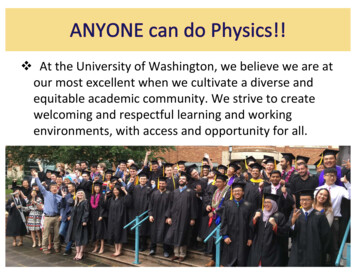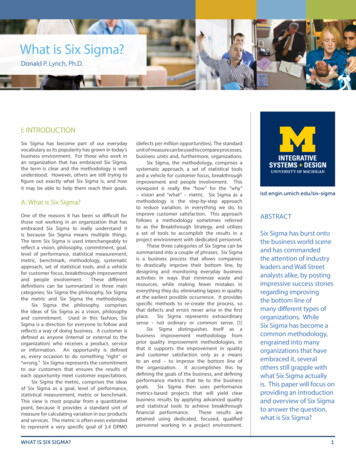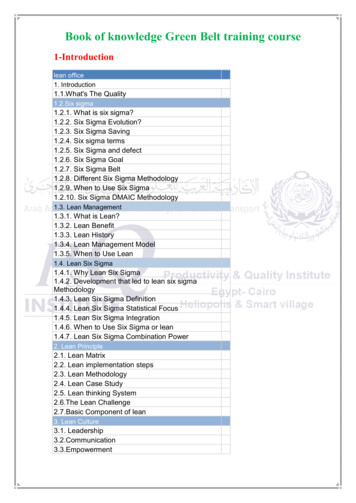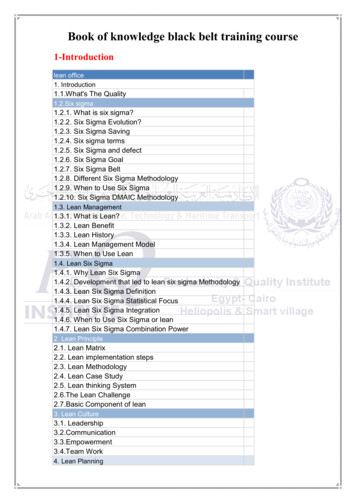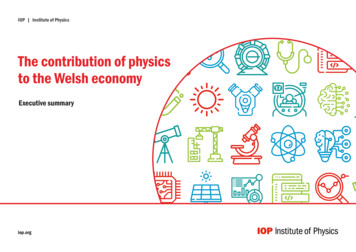
Transcription
Continue
Six ideas that shaped physics unit c answer keySome Physical Constants Speed of light Gravitational constant Coulomb's constant Planck's constant Boltzmann's constant Elementary charge Electron mass Proton mass Neutron mass c G k h kg e mc m„ m„ 3.00 x 108 m/s 6.67 x 10-11 N m2/kg2 8.99 x 109 N m2/C2 6.63 x 10-34 J s 1.38 x lO- J/K 1.60 x 10-19C 9.11 x 10-31 kg 1.67 x10 27kg 1.68 x 10-27 kg 1018 1015 1012 109 106 103 10 2 10 101-6 10 10 10 101-18 Commonly Used Physical Data Gravitational field strength g Mass of the earth Me Radius of the earth Re Mass of the sun Ms Radius of the sun R:. Distance to moon Distance to sun Density of water1" Density of air1" Absolute zero Freezing point ofwater* Room temperature Boiling point of water* Normal atmospheric pressure 9.80 J kg 1 m"1 9.80 m/s2 5.98 x 1024 kg 6380 km (equatorial) 1.99 x 103 kg 696,000 km 3.84 x 108 m 1.50 x 10" m 1000.0 kg/m3 1 g/cm3 1.2 kg/m3 0 K -273.15 C -459.67 F 273.15 K 0 C 32 F 295 K 22 C 72 F 373 K : 100 C 212 F101.3 kPa exa peta tera giga mega kilo centi milli micro nano pico femto atto E P T G M k c m F n P f Useful Conversion Factors 1 meter - 1 m 100 cm 39.4 in. 3.28 ft 1 mile 1 mi i609 m l m 52gQ ft 1mch 1 in. 2.54 cm 1 hght-year 1 ly 9 46 Pm Q 946 x 1q16 m hour 1 h 60 min 3600 s ay 1 d 24 h 86.4ks 86,400 s 1 f-i 7 1 y2 f525 d 31-6 Ms 3.16 x 107 s 3" g m /s 1 N-m 0.239 cal 1 cal 4.186 J 1 W 1J/S lkW-h 3.6MJ 1K (temperature difference) 1 C 18 F , /1K\ ' T ' l c j fTrc] 273.15 C] 1 rad 57.30 0.1592 rev 1 m/s 2.24 mi/h 1 mi/h 1.61 km/h 1 ft3 0.02832 m3 1 gallon 1 gal 3.79 x 10"3 m3 3.8 kg H20 1N 1 kg m/s2 1 J/m 0.225 lb 1 lb 4.45 N Weight of 1-kg object near earth 9.8 N 2.2 lb 1 cal energy to raise temperature of 1 g of H20 by 1 K 1 food calorie 1 Cal 1 kcal 1000 cal 1 horsepower 1 hp 746 W 1 Pa 1 «— j. N/m m2 T F5 C\ T \ 9 F / 1 F 1 5K 9 F (T[FJ — 32 F) 459.67 F) 1 rev 360 2n radians 6.28 rad At normal pressure, 20 C. 1At normal atmospheric pressure. Useful Astronomical Data (1 AU mean distance from earth to sun 1.50 x 10n m) Object Sun Moon Mercury Venus Earth Mars Jupiter Saturn Uranus Neptune Pluto/ Charon Ceres (asteroid) Halley's comet Mass Radius 1.99 x 1030 kg 696,000 km 7.36 x 1022 kg1,740 km 0.0558M 2,439 km 0.815Me 6,060 km 5.98 x 1024 kg Me 6,380 km 0.107M 3,370 km 318M 69,900 km 95.1M 58,500 km 14.5M 23,300 km 17.2M 22,100 km 0.0025M 3500/1800 km 1.2 x 1021 kg 500 km 1.2 x 1014 kg 7 km Mean Orbital Radius 384,000 km 0.387 AU 0.723 AU 1.000 AU 1.524 AU 5.203 AU 9.539AU 19.182 AU 30.058 AU 39.785 AU 2.768 AU 17.94 AU Orbital Period 27.3 d 0.241 y 0.615 y 1.000 y 1.88 y 11.9 y 29.5 y 84.0 y 165 y 248 y 4.61 y 76.0 y Fundamentals of Physics, 3/e, New York: Wiley, p. A6. Orbital Eccentricity 0.055 0.206 0.007 0.017 0.093 0.048 0.056 0.047 0.009 0.254 0.077 0.967 , Thomas A. Moore BostonBurr Ridge, IL Bangkok Milan Bogota Montreal Dubuque, IA Caracas New Delhi Madison, Wl Kuala Lumpur Santiago Seoul New York Lisbon San Francisco London Singapore Madrid Sydney St. Louis Mexico City Taipei Toronto McGraw-Hill Higher Education A Division of The McGraw-Hill Companies SIX IDEAS THAT SHAPEDPHYSICS, UNIT N: THE LAWS OF PHYSICS ARE UNIVERSAL SECOND EDITION Published by McGraw-Hill, a business unit of The McGraw-Hill Companies, Inc., 1221 Avenue of the Americas, New York, NY 10020. Copyright 2003, 1998 by The McGraw-Hill Companies, Inc. All rights reserved. No part of this publication may bereproduced or distributed in any form or by any means, or stored in a database or retrieval system, without the prior written consent of The McGraw-Hill Companies, Inc., including, but not limited to, in any network or other electronic storage or transmission, or broadcast for distance learning. Some ancillaries, including electronic and printcomponents, may not be available to customers outside the United States. This book is printed on recycled, acid-free paper containing 10% postconsumer waste. 4 5 6 78 9 0 QPD/QPD 0 9 8 7 6 ISBN 978-0-07-239712-3 MHID 0-07-239712-8 Publisher: Kent A. Peterson Sponsoring editor: Daryl Bruflodt Developmental editor: Spencer J.Cotkin, Ph.D. Marketing manager: Debra B. Hash Senior project manager: Susan /. Brusch Lead production supervisor: Sandy Ludovissy Media project manager: Sandra M. Schnee Lead media technology producer: Judi David Designer: David W. Hash Cover/interior designer: Rokusek Design Cover image: PhotoDisc Senior photoresearch coordinator: Lori Hancock Photo research: Chris Hammond/PhotoFind LLC Supplement producer: Brenda A. Ernzen Compositor: Interactive Composition Corporation Typeface: 10/12 Palatino Printer: Quebecor World Dubuque, IA The credits section for this book begins on page 257 and is considered an extension of thecopyright page. Library of Congress Cataloging-in-Publication Data Moore, Thomas A. (Thomas Andrew) Six ideas that shaped physics. Unit N. The laws of physics are universal / Thomas A. Moore. — 2nd ed. p. cm. Includes bibliographical references and index. ISBN 0-07-239712-8 (acid-free paper) Is Mechanics. I. Title: Laws ofphysics are universal. II. Title QC125.2 .M66 531.7—dc21 www.mhhe.com 2003 2002070885 PTP Dedication For Brittany, whose intuitive understanding ofnewtonian mechanics is part of what makes her awesome. Table of Contents for Six Ideas That Shaped Physics Unit C Unit R Conservation Laws Constrain Interactions The Laws ofPhysics Are Frame-Independent CI C2 C3 C4 C5 C6 C7 C8 C9 CIO Cll C12 C13 C14 R1 R2 R3 R4 R5 R6 R7 R8 R9 RIO Introduction to Interactions Vectors Interactions Transfer Momentum Particles and Systems Applying Momentum Conservation Introduction to Energy Some Potential Energy Functions Force and Energy RotationalEnergy Thermal Energy Energy in Bonds Power, Collisions, and Impacts Angular Momentum Conservation of Angular Momentum The Principle of Relativity Synchronizing Clocks The Nature of Time The Metric Equation Proper Time Coordinate Transformations Lorentz Contraction The Cosmic Speed Limit Four-Momentum Conservationof Four-Momentum Unit E Electric and Magnetic Fields Are Unified Unit N The Laws of Physics Are Universal Nl N2 N3 N4 N5 N6 N7 N8 N9 N10 Nil N12 N13 Newton's Laws Vector Calculus Forces from Motion Motion from Forces Statics Linearly Constrained Motion Coupled Objects Circularly Constrained Motion Noninertial ReferenceFrames Projectile Motion Oscillatory Motion Introduction to Orbits Planetary Motion El E2 E3 E4 E5 E6 E7 E8 E9 E10 Ell E12 E13 E14 E15 E16 Basic Electrostatics Electric Fields Electrostatic Potential Conductors Driving Currents Analyzing Circuits Magnetic Fields Currents and Magnets Symmetry and Flux Gauss' Law Ampere's LawThe Electromagnetic Field Maxwell's Equations Induction Waves Electromagnetic Waves Table of Contents for Six Ideas That Shaped Physics viii Unit Q Particles Behave Like Waves Ql Q2 Q3 Q4 Q5 Q6 Q7 Q8 Q9 Q10 Qll Q12 Q13 Standing Waves The Wave Nature of Light The Particle Nature of Light The Wave Nature of Matter TheQuantum Facts of Life The Wavefunction Bound Systems Spectra Understanding Atoms The Schrodinger Equation Energy Eigenfunctions Introduction to Nuclei Stable and Unstable Nuclei Q14 Q15 Radioactivity Nuclear Technology UnitT Some Processes Are Irreversible T1 T2 T3 T4 T5 T6 T7 T8 T9 Temperature Ideal Gases GasProcesses Macrostates and Microstates The Second Law Temperature and Entropy Some Mysteries Resolved Calculating Entropy Changes Heat Engines Contents: Unit N The Laws of Physics Are Universal About the Author Preface xiii XV introduction for Students N3.5 N3.6 N3.7 xix Coupling Forces Graphs of One-DimensionalMotion A Few Quantitative Examples Two-Minute Problems Answers to Exercises 47 48 51 52 56 Chapter N1 Newton's Laws Nl.l N1.2 N1.3 N1.4 N1.5 N1.6 Chapter Overview The Newtonian Synthesis Newton's First Law Newton's Third Law Newton's Second Law Classification of Forces Free-Body Diagrams Two-Minute ProblemsHomework Problems Answers to Exercises 2 2 4 6 7 8 11 13 14 16 17 Chapter N4 Motion from Forces N4.1 N4.2 N4.3 N4.4 N4.5 N4.6 N4.7 Chapter Overview The Reverse Kinematic Chain Graphical Antiderivatives Integrals for One-Dimensional Motion Free Fall in One Dimension Integrals in Three Dimensions Constructing TrajectoryDiagrams The Newton Program Two-Minute Problems Homework Problems Answers to Exercises 58 58 60 60 62 66 67 69 71 73 74 76 Chapter N2 Vector Calculus N2.1 N2.2 N2.3 N2.4 N2.5 N2.6 Chapter Overview The Time Derivative of a Vector The Definition of Velocity The Definition of Acceleration Motion Diagrams NumericalResults from Motion Diagrams Uniform Circular Motion Two-Minute Problems Answers to Exercises 18 18 20 21 24 26 30 31 34 37 Chapter Nb 78 Statics N5.1 N5.2 N5.3 N5.4 N5.5 Chapter Overview Forces from Motion: An Overview Introduction to Statics Statics Problems Involving Torque Solving Force-from-Motion Problems SolvingStatics Problems Two-Minute Problems Homework Problems Answers to Exercises 78 80 80 81 84 86 90 91 93 Chapter N3 Forces from Motion N3.1 N3.2 N3.3 N3.4 Chapter Overview The Kinematic Chain Net-Force Diagrams Qualitative Examples Third-Law and Second-Law Pairs 38 38 40 40 41 46 Chapter N6 Linearly ConstrainedMotion N6.1 N6.2 Chapter Overview Free-Particle Diagrams Motion at a Constant Velocity 94 94 96 97 Contents: Unit N X N6.3 N6.4 N6.5 N6.6 Static and Kinetic Friction Forces Drag Forces Linearly Accelerated Motion A Constrained-Motion Framework Two-Minute Problems Flomework Problems Answers to Exercises 98 103 104 105108 109 111 Chapter N10 Projectile Motion N10.1 N10.2 N10.3 N10.4 N10.5 Chapter N7 Coupled Objects N7.1 N7.2 N7.3 N7.4 N7.5 Chapter Overview Force Notation for Coupled Objects Pushing Blocks Strings, Real and Ideal Pulleys Using the Framework Two-Minute Problems Homework Problems Answers to Exercises 112 112 114116 118 122 122 124 125 128 N8.1 N8.2 N8.3 N8.4 N8.5 Chapter Overview Uniform Circular Motion Directionals Nonuniform Circular Motion Banking Examples Two-Minute Problems Homework Problems Answers to Exercises Oscillatory Motion Nll.l Nil .2 N11.3 N11.4 Nil.5 Nil.6 130 130 132 134 135 137 140 143 145 147 Chapter N9Noninertial Frames N9.1 N9.2 N9.3 N9.4 N9.5 N9.6 N9.7 Chapter Overview Fictitious Forces The Galilean Transformation Inertial Reference Frames Linearly Accelerating Frames Circularly Accelerating Frames Using Fictitious Forces Freely Falling Frames and Gravity Two-Minute Problems Homework Problems Answers to ExercisesIntroduction to Orbits N12.1 N12.2 N12.3 N12.4 N12.5 N12.6 186 186 188 189 192 193 195 197 199 200 202 Chapter Overview Kepler's Laws Orbits Around a Massive Primary Kepler's Second Law Circular Orbits and Kepler's Third Law Circular Orbit Problems Black Holes and Dark Matter Two-Minute Problems Homework ProblemsAnswers to Exercises 204 204 206 207 209 210 212 217 219 219 221 Chapter N13 Planetary Motion 161 163 164 166 Chapter Overview A Mass on a Spring Solving the Equation of Motion The Oscillator as a Model A Mass Hanging from a Spring An Analogy to Circular Motion The Simple Pendulum Two-Minute Problems HomeworkProblems Answers to Exercises Chapter N12 148 148 150 150 154 156 158 159 168 170 171 173 174 178 180 181 184 Chapter N11 Chapter N8 Circularly Constrained Motion Chapter Overview Weight and Projectile Motion Simple Projectile Motion Some Basic Implications A Projectile Motion Framework Drag and Terminal Speed TwoMinute Problems Homework Problems Answers to Exercises 168 N13.1 N13.2 N13.3 Chapter Overview Ellipses and Hyperbolas Trajectory Diagrams for Orbits Conservation Laws and Orbits 222 222 224 227 231 xi Contents: Unit N N13.4 Solving Orbit Problems Two-Minute Problems Homework Problems Answers to Exercises 233 236237 239 Appendix NA Differential Calculus NA.l NA.2 NA.3 NA.4 NA.5 Derivatives Some Useful Rules Derivatives and Slopes The Chain Rule Derivatives of Other Functions Homework Problems Answers to Exercises 241 241 241 243 243 244 245 245 Appendix NB Integral Calculus NB.l NB.2 NB.3 NB.4 NB.5 Antiderivatives DefiniteIntegrals The Fundamental Theorem Indefinite Integrals Substitution of Variables Homework Problems Answers to Exercises 246 246 246 247 248 249 250 250 Glossary 251 Credits 257 Index 259 About the Author Introduction TT I Thomas A. Moore graduated from Carleton College (magna cum laude with Distinction in Physics) in1976. He won a Danforth Fellow ship that year that supported his graduate ed ix 0eode--»ic \v Sf ucation at Yale University, where he earned a jov-lcS m spo eiil Ph.D. in 1981. He taught at Carleton College 0' ClxVVoAu \ bullet \ \ in 1991. He served as an active member of the steering committee for the national Introduc 1 Jff esittory University Physics Project (IUPP) from 1987 through 1995. This textbook grew out of a model curriculum that he developed for that gS vsVcsucc "bo mx! project in 1989, which was one of only four se lected for further development and testing a y tied 1 by IUPP. ('and -'0 He has published a number of articles about astrophysicalsources of gravitational waves, detection of gravitational waves, and new approaches to teaching physics, as well as a book on special relativity entitled "A Traveler's Guide to Spacetime" (McGraw-Hill, 1995). He has also served as a reviewer and an associate editor for American Journal of Physics. He currently lives in Claremont,California, with his wife Joyce and two college-aged daughters. When he is not teaching, doing research in relativistic astrophysics, or writ ing, he enjoys reading, hiking, scuba diving, teaching adult church-school classes on the Hebrew Bible, calling contradances, and playing traditional Irish fiddle music. Preface Introduction This volumeis one of six that together comprise the text materials for Six Ideas That Shaped Physics, a fundamentally new approach to the two- or threesemester calculus-based introductory physics course. Six Ideas That Shaped Physics was created in response to a call for innovative curricula offered by the Introductory University Physics Project(IUPP), which subsequently sup ported its early development. In its present form, the course represents the culmination of more than a decade of development, testing, and evaluation at a number of colleges and universities nationwide. This course is based on the premise that innovative approaches to the pre sentation of topics and toclassroom activities can help students learn more ef fectively. I have completely rethought from the ground up the presentation of every topic, taking advantage of research into physics education wherever possible, and have done nothing just because "that is the way it has always been done." Recognizing that physics education researchhas consistently emphasized the importance of active learning, I have also provided tools sup porting multiple opportunities for active learning both inside and outside the classroom. This text also strongly emphasizes the process of building and cri tiquing physical models and using them in realistic settings. Finally, I have sought toemphasize contemporary physics and view even classical topics from a thoroughly contemporary perspective. I have not sought to "dumb down" the course to make it more accessible. Rather, my goal has been to help students become smarter. I intentionally set higher-than-usual standards for sophistication in physical thinking, and Ithen used a range of innovative approaches and classroom structures to help even average students reach this standard. I don't believe that the mathemati cal level required by these books is significantly different from that in most university physics texts, but I do ask students to step beyond rote thinking pat terns to develop flexible,powerful conceptual reasoning and model-building skills. My experience and that of other users are that normal students in a wide range of institutional settings can, with appropriate support and practice, meet these standards. The six volumes that comprise the complete Six Ideas course are Unit C (Conservation laws): Unit N (Newtonianmechanics): Unit R (Relativity): Unit E (Electricity and magnetism): Unit Q (Quantum physics): Unit T (Thermal physics): Conservation Laws Constrain Interactions The Laws of Physics Are Universal The Laws of Physics Are Frame-Independent Electric and Magnetic Fields Are Unified Particles Behave Like Waves Some Processes AreIrreversible I have listed these units in the order that I recommend they be taught, al though other orderings are possible. At Pomona, we teach the first three units during the first semester and the last three during the second semester Opening comments about Six Ideas That Shaped Physics The six volumes of the Six Ideas text xviPreface of a year-long course, but one can easily teach the six units in three quarters or even over three semesters if one wants a slower pace. The chapters of all these texts have been designed to correspond to what one might realistically discuss in a single 50-minute class session at the highest possible pace. A rea sonable coursesyllabus will therefore set an average pace of not more than one chapter per 50 minutes of class time. For more information than I can include in this short preface about the goals of the Six Ideas course, its organizational structure (and the rationale behind that structure), the evidence for its success, and guidance on how to cut and/orrearrange material, as well as many other resources for both teachers and students, please visit the Six Ideas website (see the next section). Important Resources Instructions about how to use this text The Six Ideas website I have summarized important information about how to read and use this text in an Introduction for Studentsimmediately preceding the first chapter. Please look this over, particularly if you have not seen other volumes of this text. The Six Ideas website contains a wealth of up-to-date information about the course that I think both instructors and students will find very useful. The URL is www.physics.pomona.edu/sixideas/ Essential computerprograms One of the most important resources available at this site is a number of computer applets that illustrate important concepts and aid in difficult calcu lations. In critical places, this unit draws on one of these programs, and past experience indicates that students learn the ideas much more effectively when these programs areused both in the classroom and for homework. These applets are freeware and are available for both the Mac (Classic) and Windows operating systems. Some Notes Specifically About Unit N The purpose and place of this unit in the course The unit's spiral structure 1 Motion maps, trajectory diagrams, and the Newton program Thisparticular unit is primarily focused on Newton's second law and its ap plication to both terrestrial and celestial physics. Its goal is to help students appreciate the power and breadth of the newtonian perspective as well as the historical importance of Newton's work. This unit is structured on the premise that students have already studiedunit C, and indeed it draws on ideas from almost all the chapters of that unit. It in turn is needed as basic background for all the other units in the course. This unit is designed to teach newtonian mechanics by using a "spiral learning" approach. The first four chapters provide a mostly qualitative in troduction to the concepts and techniquesof newtonian mechanics, while the remaining chapters explore quantitative applications of these ideas in depth. Instructors can help students get the most out of this approach by helping them see the connections between the earlier and later spirals through the given material. An unusual feature of the first part of this text is theexploration of mo tion using motion maps and trajectory diagrams. Both of these tools are de signed to deepen students' intuitive understanding of motion, and trajectory diagrams in particular are a powerful tool for qualitatively predicting an ob ject's motion in advance of using mathematics. If students spend enough xvii Preface timepracticing the use of both of these tools, their understanding of newtonian mechanics will become much deeper and more flexible. I have also discussed the trajectory diagram in such depth because it provides an excellent conceptual basis for computer programs that calculate trajectories. The Newton computer program, which isavailable for free download from the Six Ideas website, does exactly this. For this edition, I have built this program into the presentation and have provided a number of new problems that use it. This program makes it possible to explore a number of realistic applications of Newton's second law that would otherwise be inac cessible, andgreatly simplifies the presentation of planetary motion in chap ter N13.1 strongly recommend to instructors that you use this program con sistently starting in chapter N4, so that your students get used to what the program does and how it operates before getting to chapter N13. Unit N, like unit C, is a mostly indivisible whole. Chapter N5(which looks at torque and statics problems) could probably be omitted if cuts are absolutely necessary: it is not essential for anything else in the course. Chap ter N13 also covers material that is not needed in the rest of the course, but would recommend against omitting this chapter: dropping chapter N13 means that students would notsee the fulfillment of the unit s great idea. In short, if cuts need to be made, start with chapter N5 and/or N13, but all the other chapters have important roles to play. Please see the instructor's manual for more detailed comments about this unit and suggestions about how to teach it effectively. Possible c Appreciation A project of thismagnitude cannot be accomplished alone. I would first like to thank the others who served on the IUPP development team for this project. Edwin Taylor, Dan Schroeder, Randy Knight, John Mallinckrodt, Alma Zook, Bob Hilborn and Don Holcomb. I'd like to thank John Rigden and other mem bers of the IUPP steering committee for theirsupport of the project in its early stages, which came ultimately from an NSF grant and the special efforts of Duncan McBride. Users of the texts—especially Bill Titus, Richard Noer, Woods Halley, Paul Ellis, Doreen Weinberger, Nalini Easwar, Brian Watson, Jon Eggert, Catherine Mader, Paul De Young, Alma Zook, David Tanenbaum,Alfred Kwok, Dan Schroeder, and Dave Dobson—have offered invaluable feedback and encouragement. I'd also like to thank Alan Macdonald, Roseanne Di Stefano, Ruth Chabay, Bruce Sherwood, and Tony French for ideas, support, and useful suggestions. Thanks also to Robs Muir for helping with several of the indexes. My editorsJim Smith, Denise Schanck, Jack Shira, Karen Allanson, Lloyd Black, J.P. Lenney, and Daryl Bruflodt as well as Spencer Cotkin, Donata Dettbarn, David Dietz, Larry Goldberg, Sheila Frank, Jonathan Alpert, Zanae Roderigo, Mary Haas, Janice Hancock, Lisa Gottschalk, Debra Hash, David Hash, Patti Scott, Chris Hammond, BrittneyCorrigan-McElroy, Rick Hecker, and Susan Brusch have all worked very hard to make this text happen, and I deeply appreciate their efforts. I'd like to thank all the reviewers, including Edwin Carlson, David Dobson, Irene Nunes, Miles Dressier, O. Romulo Ochoa, Qichang Su, Brian Watson,' and Laurent Hodges, for taking the time to do acareful reading of var ious units and offering valuable suggestions. Thanks to Connie Wilson, Hilda Dinolfo, and Connie Inman, and special student assistants Michael Wanke, Paul Feng, Mara Harrell, Jennifer Lauer, Tony Galuhn, and Eric Pan, and all the Physics 51 mentors for supporting (in various ways) the development and Thanks!xviii Preface teaching of this course at Pomona College. Thanks also to my Physics 51 stu dents, and especially Win Yin, Peter Leth, Eddie Abarca, Boyer Naito, Arvin Tseng, Rebecca Washenfelder, Mary Donovan, Austin Ferris, Laura Siegfried, and Miriam Krause, who have offered many suggestions and have together found manyhundreds of typos and other errors. Eric Daub and Daniel Villalon were indispensable in helping me put this edition together. Finally, very special thanks to my wife, Joyce, and to my daughters, Brittany and Allison, who contributed with their support and patience during this long and demanding project. Heartfelt thanks to all! Thomas A.Moore Claremont, California Introduction for Students Introduction Fundamentals Newton's Laws Welcome to Six Ideas That Shaped Physics'. This text has been designed using insights from recent research into physics learning to help you learn physics as effectively as possible. It thus has many features that may be different fromscience texts you have probably encountered. This section discusses these features and how to use them effectively. Why Is This Text Different? Research consistently shows that people learn physics most effectively if they participate in activities that help them practice applying physical reason ing in realistic situations. This is becausephysics is not a collection of facts to absorb, but rather is a set of thinking skills requiring practice to master. You cannot learn such skills by going to factual lectures any more than you can learn to play the piano by going to concerts! This text is designed, therefore, to support active learning both inside and outside the classroom byproviding (1) resources for various kinds of learn ing activities, (2) features that encourage active reading, and (3) features that make it easier for the text (as opposed to lectures) to serve as the primary source of information, so that more class time is available for active learning. Vector Calculus Forces from Motion Motion from Forces Forces from Motion [ Motion from Forces The Text as Primary Source To serve the last goal, I have adopted a conversational style that I hope will be easy to read, and I tried to be concise without being so terse that you need a lecture to fill in the gaps. There are also many text features designed to help you keep track of the big picture.The unit's central idea is summarized on the front cover where you can see it daily. Each chapter is designed to corre spond to one 50-minute class session, so that each session is a logically com plete unit. The two-page chapter overview at the beginning of each chapter provides a compact summary of that chapter's contents to considerbefore you are submerged by the details (it also provides a useful summary when you review for exams). An accompanying chapter-location diagram uses a computer-menu metaphor to display how the current chapter fits into the unit (see the example at the upper right). Major unit subdivisions appear as gray boxes, with the currentsubdivision highlighted in color. Chapters in the current subdivision appear in a submenu with the current chapter high lighted in black and indicated by an arrow. All technical terms are highlighted using a bold type when they first ap pear, and a glossary at the end of the text summarizes their definitions. Please also note the tables ofuseful information, including definitions of common symbols, that appear inside the front cover. A physics formula is both a mathematical equation and a context that gives the equation meaning. Every important formula in this text appears in a formula box. Each contains the equation, a Purpose (describing the formula's Features that helpthe text serve as the primary source of information Introduction for Students XX meaning and utility), a definition of the Symbols used in the equation a description of any Limitations on the formula's applicability, and possibly some other useful Notes. Treat everything in such a box as an indivisible unit to be remembered and usedtogether. Active Reading What it means to be an active reader Tools to help you become an active reader The single most important thing you can do Like passively listening to a lecture, passively scanning a text does not really help you learn. Active reading is a crucial study skill for effectively learning from this text (and other types oftechnical literature as well). An active reader stops frequently to pose internal questions such as these: Does this make sense? Is this consistent with my experience? Am I following the logic here. Do I see how I might use this idea in realistic situations? This text provides two important tools to make this easier. Use the wide margins to (1)record questions that occur to you as you read (so that you can remember to get them answered), (2) record answers when you receive them, (3) flag important passages, (4) fill in missmg math ematics steps, and (5) record insights. Doing these things helps keep you ac tively engaged as you read, and your marginal comments are alsogenerally helpful as you review. Note that I have provided some marginal notes that summarize the points of crucial paragraphs and help you find things quickly. The in-text exercises help you develop the habits of (1) filling in missing mathematics steps and (2) posing questions that help you practice using the chapter's ideas. Also,although this text has many examples of worked prob lems similar to homework or exam problems, some of these appear in the form of in-text exercises (as you are more likely to learn from an example if you work on it a bit yourself instead of just scanning someone else's solu tion). Answers to all exercises appear at the end of eachchapter so you can get immediate feedback on how you are doing. Doing at least some of the ex ercises as you read is probably the single most important thing you can do to be come an active reader. Active reading does take effort. Scanning the 5200 words of a typical chapter might take 45 minutes, but active reading could takeseveral times as long. I personally tend to "blow a fuse" i
Six ideas that shaped physics unit c answer key Some Physical Constants Speed of light Gravitational constant Coulomb's constant Planck's constant Boltzmann's constant Elementary charge Electron mass Proton mass Neutron mass c G k h kg e mc m„ m„ 3.00 x 108 m/s 6.67 x 10-11 N m2/kg2 8.99 x 109 N m2/C2 6.63 x 10-34 J s 1.38 x lO- J/K 1.60 x 10-19C 9.11 x 10-31 kg 1.67 x

